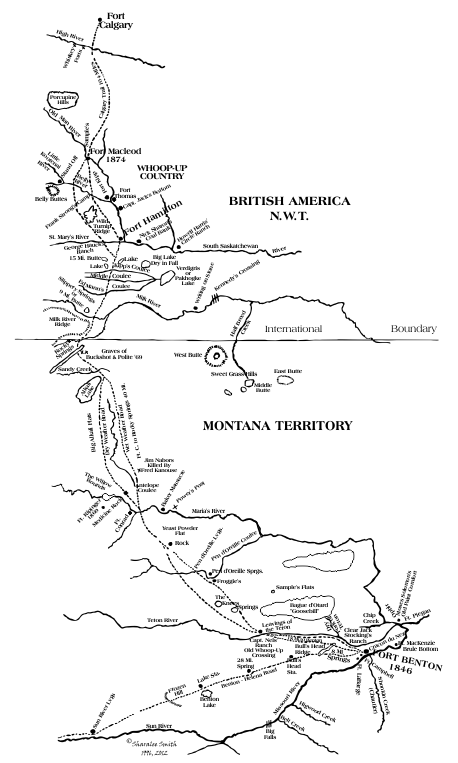
|
In 1869, John Healy and Al Hamilton headed north from Fort
Benton to establish a trading post across the Medicine Line.
Roughly paralleling the Old North Trail, they traveled
across a rolling prairie, cut up by coulees, and covered
with prickly pear cactus and short prairie grass. At
the junction of the Oldman River and St. Mary's river, near
present day Lethbridge, they constructed Fort Whoop-Up known
as Fort Hamilton.
Although the origin of the name has been lost
in time, the importance of the trail they pioneered, The Whoop-Up Trail, is not debated.
The Trail, of approximately 240 miles played an important
role in the history of the U.S. and Canadian frontier from
the 1850s until the 1880's.
The trail was traversed on foot, on horseback, by
mule train, by trade wagons, by fur
trappers, whiskey traders, the U.S. Army, the North-West
Mounted Police (NWMP), cowboys, miners, ranchers, and
settlers.
Fort
Benton, which is located on the North side of the Missouri River,
in Montana became a center for trade for northern Montana
and southern Alberta for more than forty years. From 1860 to
1890 more than 600 steamboat landings allowed goods and
commerce to reach both U.S. and Canadian frontier
communities.
Through Fort Benton passed many of the bison robes
that made their way to eastern markets from 1865 to 1882.
Furs, whiskey, and trade goods were a staple of the commerce
on this trail, although with the coming of the NWMP to
western Canada in 1874, the whiskey forts and the whiskey
trade began to decline. Supplies for the NWMP and Indian
reservations became part of the goods carried by bull trains
across
the border.
The coming of the railroad lessened the need for
the trail, and by 1890 it no longer played a significant
role in the economic life of this region.
Today, most of the Trail has been plowed under, but vestiges
of this once important route can still be found on
undisturbed pasture lands and at a few river crossings.
|
|